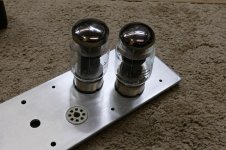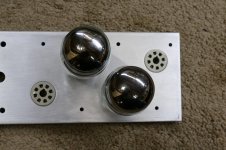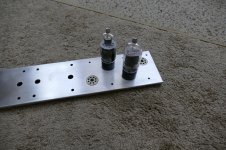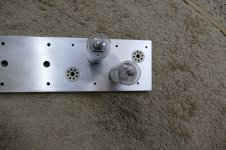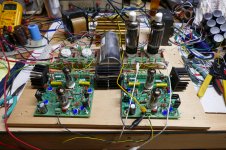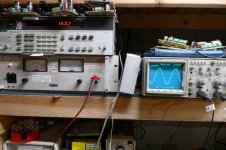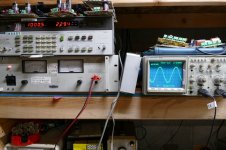This is all very well timed for me. I have been thinking of building a push pull tube amp for my main system. My system is active and uses 4 amps per channel. I'm looking to build something to power the mid bass drivers. Time and experimentation have told me I like something with quite a bit of power. The speakers are open baffle and I do have a tendency to listen LOUD.
Seems like a good place to start is deciding what tubes to use. KT88 seems an obvious choice but what about 4d32 or 811A both can be had for not too much money.
I'm a very good mechanic but I definitely need some hand holding in the design process and will need some help/guidance.
Evan
Seems like a good place to start is deciding what tubes to use. KT88 seems an obvious choice but what about 4d32 or 811A both can be had for not too much money.
I'm a very good mechanic but I definitely need some hand holding in the design process and will need some help/guidance.
Evan
KT88 seems an obvious choice
KT88's are a good choice for power levels in the 50 to 80 WPC range and up until last night they were my choice. There is at least one other builder interested in a KT88 amp, so I will follow a KT88 design through to completion, but I may not go that direction for my first amp build. I have tested the KT88's / 6550's in triode, ultralinear and pentode mode, and I am thoroughly satisfied with the way the breadboarded amp works and sounds.
I have a chassis that was provided to me by Landfall Systems in exchange for building up a unique amp design and featuring it here and on my web site. That effort was well underway when my 41 year career ended without much warning, although it (and the whole company) had been on life support for years. A freak occurrence with the sale of our house required us to pack up everything and move out on 3 weeks notice. The chassis and most of my "stuff" got shoved into random boxes and moved twice before we settled into our "retirement" home 1200 miles north of where I had lived all my life. There are still some boxes that haven't been opened since we packed them in Florida.
I was planning a 100 WPC 13GB5 sweep tube amp for the Landfall chassis when it all got stuffed into storage. The design was mocked up, and the picture in post #86 was my only reminder of that design. The mounting plate for the OPT's and output tubes was drilled to match that mock-up in Florida, right before I boxed it all up.
Last night I got the chassis out of storage, put it together and found a serious problem. The Russian KT88's that I have are 2 inches in diameter. The Mullard 13GB5's that I drilled the chassis out for are 1 1/16 inches in diameter. What was plenty of room is now far too close. I need to find some smaller tubes! Preferably tubes that are a little more efficient than the KT88's, so that there is less heat generated.
but what about 4d32 or 811A
811A's would be tricky to make a good HiFi amp with because of their high Mu. True, they require very little drive voltage, but we have a driver board capable of lots of voltage. The high Mu brings along a high plate resistance which translates to a rather high output impedance and a damping factor around 1 or 2 unless a lot of feedback is applied. Many OB speakers don't need much damping, so that may be OK, but I haven't experimented with the 811A in recent years.
The 4D32 is a different story. They were briefly tested in post #654 of the thread that designed the predecessor to this driver board. When tested with this version of the driver board I got 200 watts from a pair. You will need 650 volts and a big OPT to get 200W, but you don't have to squeeze them that hard.
6L6GC AB2 Amp
Whenever building an amp that you intend to keep for many years, plan on using tubes like the KT88 which will be made as long as guitar players keep blowing them up, or collect a lifetime supply of whatever tubes that you use.
The size of the 4D32 and the fact that I only have 6 good ones will keep them out of this build for me, but the same concepts apply.
I have long been a fan of TV sweep tubes, and I have started digging through my collection to see if there is a tall skinny candidate that I have lots of. Since designing my 13GB5 amp nearly 5 years ago, someone bought up nearly ALL of the existing supply. I wound up selling all of mine for far more than I paid for them.
I know that the 6HJ5 will crank out 125 WPC from 620 volts through these OPT's, and I have some, so that's a possibility. I'm looking for something skinnier though.
The first two pictures show the output sub-chassis with a pair of EH KT88's in it. The 3rd and 4th pictures show the same chassis with 6CB5's.
Attachments
Are you concerned that the KT88's on your chassis are too close and won't have enough ventilation? Is there are rule of thumb for that.
The 300B's that I put on my TSE look a lot closer than that. Should I be concerned?
I guess EL34's are skinny enough, but don't have the power you are looking for.
The 300B's that I put on my TSE look a lot closer than that. Should I be concerned?
I guess EL34's are skinny enough, but don't have the power you are looking for.
I have seen several "rules of thumb" regarding tube spacing, and yes the TSE with 300B's does violate most of them. The TSE was originally designed for 45's, I never thought of sticking 300B's in it, but one of the guys I sold one of the early amps to did it and ten years later the 300B is the norm. WE 300B's, the early Russian and Chinese clones ran at 360 volts. Today there are "300B's" that eat over 400 volts.
The most common "rule" that I have seen is to space the tubes from each other, the transformers, or any other solid object a distance equal to their diameter. It is also a rule that's commonly violated by even the big name tube amp makers of the past.
I imagine the real spacing requirement would depend on how hard the tubes were run, how much ventilation they receive and how many tubes and other heat radiating objects are nearby. Even the color of the surroundings matter, shiny silver will reflect the heat back into the tubes, while black will absorb it. A tube does not usually radiate heat evenly. Beam tubes like the KT88 shed their heat off two opposing sides, where the electron beam hits the plate. The Electro Harmonix KT88's have heat radiating fins to more evenly distribute the heat. The others do not.
The chassis that I am committed to using puts 4 output tubes inside a rack mount cabinet with a side wall on one side of the tubes, and the OPT's on the other side. The KT88's that I have are rather short and fat, with all the heat being radiated from a 1.5 inch tall plate. The tube to tube spacing is just 3/8 of an inch and that is maintained for 1/2 inch past either end of the plate. The 300B's on the other hand are only close at one point.
I am now looking at some TV sweep tubes that are 1 7/16 inches in diameter with a 2 inch tall plate. They would open the tube to tube spacing up to just over 3/4 inch. The heat radiating area (the plate) is 1/2 an inch taller, so for the same dissipation the heat is more spread out. That's two small steps in the right direction. TV sweep tubes have been more efficient than typical audio tubes in my past experience, so this could mean less overall heat generation for the same power output.
I really should have opened up the chassis box earlier.....it's a bit smaller than I remembered. I still want to squeeze a 60 to 100 WPC amp inside it if possible.
I am in the process of rewiring the breadboard for some TV sweep tube testing, starting with the biggest tubes I have.....trying to spread out the heat.....and to see what they will do when maxed out. I have a 500 WPC amp planned for sometime in the future.
The most common request for an amp like this is still the KT88, primarily because it's still being made, and it's the biggest affordable "audio" tube out there. I will get back to the KT88 as soon as I test out a few other tubes. I plan to map out how much power you can get for a 3300 ohm, 5000 ohm, and 6600 ohm OPT for various voltage levels and measure the required current. This will make picking power transformers far easier.
The most common "rule" that I have seen is to space the tubes from each other, the transformers, or any other solid object a distance equal to their diameter. It is also a rule that's commonly violated by even the big name tube amp makers of the past.
I imagine the real spacing requirement would depend on how hard the tubes were run, how much ventilation they receive and how many tubes and other heat radiating objects are nearby. Even the color of the surroundings matter, shiny silver will reflect the heat back into the tubes, while black will absorb it. A tube does not usually radiate heat evenly. Beam tubes like the KT88 shed their heat off two opposing sides, where the electron beam hits the plate. The Electro Harmonix KT88's have heat radiating fins to more evenly distribute the heat. The others do not.
The chassis that I am committed to using puts 4 output tubes inside a rack mount cabinet with a side wall on one side of the tubes, and the OPT's on the other side. The KT88's that I have are rather short and fat, with all the heat being radiated from a 1.5 inch tall plate. The tube to tube spacing is just 3/8 of an inch and that is maintained for 1/2 inch past either end of the plate. The 300B's on the other hand are only close at one point.
I am now looking at some TV sweep tubes that are 1 7/16 inches in diameter with a 2 inch tall plate. They would open the tube to tube spacing up to just over 3/4 inch. The heat radiating area (the plate) is 1/2 an inch taller, so for the same dissipation the heat is more spread out. That's two small steps in the right direction. TV sweep tubes have been more efficient than typical audio tubes in my past experience, so this could mean less overall heat generation for the same power output.
I really should have opened up the chassis box earlier.....it's a bit smaller than I remembered. I still want to squeeze a 60 to 100 WPC amp inside it if possible.
I am in the process of rewiring the breadboard for some TV sweep tube testing, starting with the biggest tubes I have.....trying to spread out the heat.....and to see what they will do when maxed out. I have a 500 WPC amp planned for sometime in the future.
The most common request for an amp like this is still the KT88, primarily because it's still being made, and it's the biggest affordable "audio" tube out there. I will get back to the KT88 as soon as I test out a few other tubes. I plan to map out how much power you can get for a 3300 ohm, 5000 ohm, and 6600 ohm OPT for various voltage levels and measure the required current. This will make picking power transformers far easier.
I have 8 4D32 tubes
Check the getter spots on each tube to make sure that they are still silver.Two out of 6 of mine were bad. The getter had turned white on one tube, and was completely gone on the other tube. After a glowing purple demonstration, the seller replaced the bad tubes. Apparently that's not uncommon with these tubes.
That was several years ago and the 6 good tubes still look OK, but I have only tested the two shown in the previous picture. I had wired a pair into one of my SSE amps back when I got them, but they don't like running in class A.
There is at least one other builder interested in a KT88 amp.
Yes, confirm
I'll have to dig the tubes out and give them a looking at. The 4d32 looks to be available and not too expensive.
What are your thoughts on using a toroidal transformer for the B+. Antek makes a unit that looks suitable and isn't super expensive. They are local to me.
AS-4T430 - 400VA 430V Transformer - AnTek Products Corp
AS-4T475 - 400VA 475V Transformer - AnTek Products Corp
What are your thoughts on using a toroidal transformer for the B+. Antek makes a unit that looks suitable and isn't super expensive. They are local to me.
AS-4T430 - 400VA 430V Transformer - AnTek Products Corp
AS-4T475 - 400VA 475V Transformer - AnTek Products Corp
Well, sort of hate to say it, 6146 is a sweep tube, might fit that spot, and is still in production. I think the chinese tubes are good for more power than the old stock types, at least that was my experience with the pair I had.
"Tung Sol" has a 7581A now. They would fit that spot, I think.
Win W5JAG
"Tung Sol" has a 7581A now. They would fit that spot, I think.
Win W5JAG
I tried an Antek 4T360 and a 4T400 on the KT88 amp back in post #90. They were compared to a Maryland toroid corp transformer that cost $280 today ($100 when I bought it).
The regulation on the Anteks are much worse than the expensive transformer. For the difference in price I would find a way to make it work. I have used Anteks in several of my projects with good results. I may wind up using one here too.....
The 4T400 gives over 600 volts unloaded, when the amp is first plugged in. The 4T430 will probably be closer to 650 volts, with the 4T475 well over 700 volts. The B+ filter caps will need to be sized accordingly.
My guess is that the 4T430 will make about 580 volts at idle, and the 4T475 somewhere near 650 volts. This is OK for the tubes. What the tubes won't like is warming up with 700+ volts on their plates. The cathode will heat up fastest in the middle, which is where all the current will flow at start up. An amp of this magnitude needs a slow warm up. The easiest way to handle this is to keep the grid bias below cutoff until the tubes are warm, or delay the screen voltage.
Since these tubes, like TV sweep tubes need a lower screen voltage, a screen regulator is needed, I will probably use some sort of delay on the screen regulator.
Before deciding which big Antek to use, investigate the voltage ratings on your choice of OPT. Many are not specified, or well below 700 volts.
The AN-4T360 resulted in about 530 volts unloaded, but the B+ dropped to about 435 volts at full crank, which was about 50 WPC. The hum and noise was similar to the expensive transformer, maybe a bit higher, but still well below 1 mV. For $57 VS $280 I wouldn't hesitate to use it. It ran for about an hour and was no warmer than the expensive transformer
The AN-4T400 resulted in 604 volts unloaded, and 545 volts at idle. With 45 mA of idle current, the idle dissipation is 24.5 watts, still lower than what I run my SSE at (435 volts 80 to 100 mA) which still has the original pair of identical EH KT88's in it. When the knob was turned up to the edge of clipping the B+ was 505 volts, making about 70 watts.
The regulation on the Anteks are much worse than the expensive transformer. For the difference in price I would find a way to make it work. I have used Anteks in several of my projects with good results. I may wind up using one here too.....
The 4T400 gives over 600 volts unloaded, when the amp is first plugged in. The 4T430 will probably be closer to 650 volts, with the 4T475 well over 700 volts. The B+ filter caps will need to be sized accordingly.
My guess is that the 4T430 will make about 580 volts at idle, and the 4T475 somewhere near 650 volts. This is OK for the tubes. What the tubes won't like is warming up with 700+ volts on their plates. The cathode will heat up fastest in the middle, which is where all the current will flow at start up. An amp of this magnitude needs a slow warm up. The easiest way to handle this is to keep the grid bias below cutoff until the tubes are warm, or delay the screen voltage.
Since these tubes, like TV sweep tubes need a lower screen voltage, a screen regulator is needed, I will probably use some sort of delay on the screen regulator.
Before deciding which big Antek to use, investigate the voltage ratings on your choice of OPT. Many are not specified, or well below 700 volts.
I assume you are not considering EL34 tubes because you cannot get enough watts out of a pair. Well, sort of hate to say it, 6146 is a sweep tube
I have not considered the EL34 or the 6146 because I don't have any 6146's and only a few GOOD EL34's. I did put the EL34's in the amp, and it isn't too hard to get 60 watts from a pair. I have about a dozen EL34's, but most are Ebay sourced junk left over from my guitar amp building days.
I have hundreds of usable tubes, some in large quantities (20 to 50 each), so I'm trying to find something that I already have. My budget for amp building right now is very small.
I am going to test the 35LR6 and the 36LW6 since they fall into the "I have 50 of each" category. There are a few others in this category too. I'm looking at an unopened box of 100 6BQ6GA's too.
Last edited:
George Thanks for the advice. I'll be building monoblocks so I can parallel the secondaries on the transformers. I would think that would help with voltage sag.
I'll look at available output tansformers. I used Electraprint transformers for my TSE and like the idea of using them for this amp. I don't know if thats a possibility. Will he make them and whats the cost.
I'll look at available output tansformers. I used Electraprint transformers for my TSE and like the idea of using them for this amp. I don't know if thats a possibility. Will he make them and whats the cost.
The Lundahl 1620 looks like it might be a choice for OT
http://www.lundahl.se/wp-content/uploads/datasheets/1620_3_7_9202.pdf
http://www.lundahl.se/wp-content/uploads/datasheets/1620_3_7_9202.pdf
I did put the EL34's in the amp, and it isn't too hard to get 60 watts from a pair.
I forgot to mention that I am already committed to a pair of Edcor 100 watt 3300 ohm OPT's. I have them and have been testing with them.
The optimum load for EL34's is a bit higher (usually 4300 ohms), so that the 3300 ohm OPT's are probably bumping up against the peak cathode current rating on a single pair of EL34's.
I'm interested in the KT88's as well
A push pull amp using 6550's or KT88's in the 50+ WPC range has been the most requested "next project" in Tubelab email for some time. I will put the KT88 test amp back together after I'm finished messing it up a bit. Whether or not I actually build a complete KT88 amp in a shiny box is yet to be determined. I imagine that I am going to run a whole bunch of different tubes through this thing before it's parts get used for a complete amp....if ever.
Note that I often use the terms 6550 and KT88 as if they are the same tube. The 6550 was GE's (USA) answer to the KT88 from the UK. They were differences at the time of introduction. I would venture that the two types of tubes from the same manufacturer today are more alike than one type from two different vendors. Evidence: I blew up one of my EH KT88's. I stuck an EH 6550 in the socket to replace it and it was a better match to the EH KT88 than the other EH KT88 was. I am convinced than there two are identical tubes. Note that I have had them for 6 to 10 years. New production may be different.
Today didn't exactly go as planned. Smoke and flames happened! On a good note, sweep tubes ROCK!
I swapped out the output tube boards for a pair of prototype universal octal output boards that were configured for one of my favorite sweep tubes, the 36LW6. These tubes come in two flavors, big (Sylvania made) and bigger (GE made). I chose the smaller of the two based on my expected output requirements, and physical size. I also have a pair of proto compactron output boards and some 35LR6's for future testing.
Fortunately I had the foresight to replace the $100 each Edcor OPT's with some cheap OPT's left over from my guitar amp making days. These were designed for budget guitar amp use, but have the same 3300 ohm impedance as the Edcors. I bought 200 of them about 20 years ago for $16 each! I have stuck these OPT's into everything from guitar amps to my 300B push pull amp. I use them for testing when I'm not sure of the outcome. In 2o years of abusing these, I have fried exactly one of them, and it was with this exact tube / OPT combination. The OPT instantaneously burst into flames when I was attempting to extract maximum power with a 750 volt supply and the load resistor blew open.
The KT88 amp drew my intended power supply down to 485 volts at full power. I would be using a bench supply for todays testing because the bid toroid and the Edcors are being test fit into the chassis. I set the power supply on 485 volts and let it rip. The KT88's started to soft clip at 65 watts and hit 5% distortion at 71 watts. The 36LW6's started to clip at 108 watts and hit 5% at 114 watts. These numbers were recorded just by changing the tubes and setting the bias.
Seeing this prompted me to turn the power supply UP! I got to 585 volts, 100 more volts than where I started when I realized that I was now pulling more power through a 50 watt OPT than I should, so I quit while I was ahead. I was reading 160 watts at 2.3% distortion, and my load resistors are rated for 120 watts.
I put tubes in the second channel, set the power supply back to 485 volts and fired it up. After setting the bias and cranking it up I noticed that the distortion was a bit higher than the previous channel, so I began to tweak. As I was adjusting the bias I noticed a jumpiness to one tube, and I saw a hint of oscillation on the scope........then a fireball erupted on one of the driver boards. Two resistors were reduced to dust and charcoal instantly and there is a burnt spot on the PCB itself.......
I had taken a shortcut, and it didn't pay off. Resistors have a voltage rating, and abusing it by a factor of three causes a stinky pile of burnt parts. I have implemented a local feedback method on these boards, and called it "experimental." The intention is to put half the resistance on the output board, and half on the driver board, for a total of 4 resistors in series. These are wired between the plates of the output tubes and the plates of the driver tubes, which are out of phase with each other. This means that they could potentially see about 3 X the B+ voltage, hence 4 resistors in series.
The KT88 test amp had 2 resistors on the driver board, and two in the air between the driver and output boards. This test had only two resistors, all on the driver boards. One of those sets ceases to exist!
I cut out all of the feedback resistors, and that channel still has issues. I will be out of town all day tomorrow, so a full autopsy will wait until at least Tuesday. The possibility of snow tomorrow night may delay that further. I have to clear my 82 year old neighbors driveway as well as my own if it snows enough.
I snapped three pictures as I cranked the first channel up to 160 watts.
I swapped out the output tube boards for a pair of prototype universal octal output boards that were configured for one of my favorite sweep tubes, the 36LW6. These tubes come in two flavors, big (Sylvania made) and bigger (GE made). I chose the smaller of the two based on my expected output requirements, and physical size. I also have a pair of proto compactron output boards and some 35LR6's for future testing.
Fortunately I had the foresight to replace the $100 each Edcor OPT's with some cheap OPT's left over from my guitar amp making days. These were designed for budget guitar amp use, but have the same 3300 ohm impedance as the Edcors. I bought 200 of them about 20 years ago for $16 each! I have stuck these OPT's into everything from guitar amps to my 300B push pull amp. I use them for testing when I'm not sure of the outcome. In 2o years of abusing these, I have fried exactly one of them, and it was with this exact tube / OPT combination. The OPT instantaneously burst into flames when I was attempting to extract maximum power with a 750 volt supply and the load resistor blew open.
The KT88 amp drew my intended power supply down to 485 volts at full power. I would be using a bench supply for todays testing because the bid toroid and the Edcors are being test fit into the chassis. I set the power supply on 485 volts and let it rip. The KT88's started to soft clip at 65 watts and hit 5% distortion at 71 watts. The 36LW6's started to clip at 108 watts and hit 5% at 114 watts. These numbers were recorded just by changing the tubes and setting the bias.
Seeing this prompted me to turn the power supply UP! I got to 585 volts, 100 more volts than where I started when I realized that I was now pulling more power through a 50 watt OPT than I should, so I quit while I was ahead. I was reading 160 watts at 2.3% distortion, and my load resistors are rated for 120 watts.
I put tubes in the second channel, set the power supply back to 485 volts and fired it up. After setting the bias and cranking it up I noticed that the distortion was a bit higher than the previous channel, so I began to tweak. As I was adjusting the bias I noticed a jumpiness to one tube, and I saw a hint of oscillation on the scope........then a fireball erupted on one of the driver boards. Two resistors were reduced to dust and charcoal instantly and there is a burnt spot on the PCB itself.......
I had taken a shortcut, and it didn't pay off. Resistors have a voltage rating, and abusing it by a factor of three causes a stinky pile of burnt parts. I have implemented a local feedback method on these boards, and called it "experimental." The intention is to put half the resistance on the output board, and half on the driver board, for a total of 4 resistors in series. These are wired between the plates of the output tubes and the plates of the driver tubes, which are out of phase with each other. This means that they could potentially see about 3 X the B+ voltage, hence 4 resistors in series.
The KT88 test amp had 2 resistors on the driver board, and two in the air between the driver and output boards. This test had only two resistors, all on the driver boards. One of those sets ceases to exist!
I cut out all of the feedback resistors, and that channel still has issues. I will be out of town all day tomorrow, so a full autopsy will wait until at least Tuesday. The possibility of snow tomorrow night may delay that further. I have to clear my 82 year old neighbors driveway as well as my own if it snows enough.
I snapped three pictures as I cranked the first channel up to 160 watts.
Attachments
I am wondering, your SSE looks awesome but the transformers go for like 140 euro a piece (europe so it'll have to be the hammond 1628). This PP design also looks great and the output transformers are much cheaper (~100 euro for a 1650) but you need an extra tube.
so just looking at the OPT and tubes the SSE and UPP should be rather close in price, but the later will have a lot more power. Am I missing something or is the UPP going to be a lot more bang for buck.
judging from your post you are already having a lot of bang right now
so just looking at the OPT and tubes the SSE and UPP should be rather close in price, but the later will have a lot more power. Am I missing something or is the UPP going to be a lot more bang for buck.
judging from your post you are already having a lot of bang right now
gideon1990,
Have you considered Toroidy? Their products seem to be more reasonably priced. I haven't used them though, so no idea on the performance. Here you go with a link for some single ended models, they have push pull iron too:
Single Ended - Shop Toroidy.pl
Have you considered Toroidy? Their products seem to be more reasonably priced. I haven't used them though, so no idea on the performance. Here you go with a link for some single ended models, they have push pull iron too:
Single Ended - Shop Toroidy.pl
Yes I know the company and have heard good things about them
But the good looking one with the metal cover costs 135 euro, without cover they cost 80 euro or something but then you either need to hide them inside the chassis or to create some kind of cover. It could be an option though because a cover bent from some perforated sheet doesn't cost much. Their push pull version does cost the same though.
P.s. does page 12 look messed up for other people too? It looks white on both my phone and pc
But the good looking one with the metal cover costs 135 euro, without cover they cost 80 euro or something but then you either need to hide them inside the chassis or to create some kind of cover. It could be an option though because a cover bent from some perforated sheet doesn't cost much. Their push pull version does cost the same though.
P.s. does page 12 look messed up for other people too? It looks white on both my phone and pc
- Home
- More Vendors...
- Tubelab
- Tubelab Universal Driver Board, 2015 version
